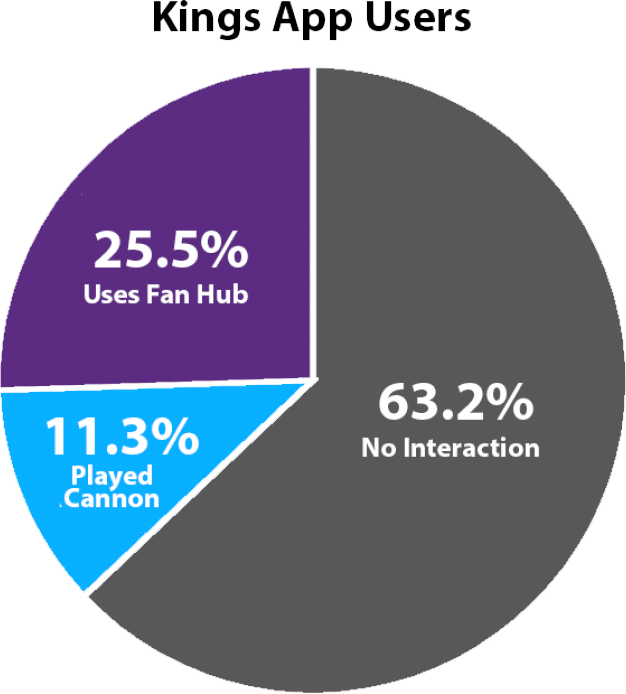KINGS CANNON
B2C Experience
A t-shirt cannon prize that can be caught no matter where you are sitting in the arena… all in the palm of your hand.
Overview
Sports teams were looking for a creative way to involve their fans digitally in between gameplay. We needed to create an experience that was innovative, allowed digital fan equity and heighten engagement with common stadium practices.
The focus was to utilize a digital platform to improve previous experiences that were done physically. If we could do that, we could increase the incentives for fans to purchase tickets to the game regardless of the price point and location of their seats.
Our goals were to create a digital experience that allows equity among fans
regardless of where they sit, have the experience be ADA compliant and minimalistic to emphasize fan entertainment vs data capture and create a seemless way to go from sports gameplay to app experience with little to no app gates
Comparable Apps
Pokemon Go
Interior design apps
Duck Hunt
Snapchat AR
Role
Product Designer
UX/UI Lead
The design team analyzed the entertainment that engages fans throughout all American sports leagues. Most interactions required randomized selection or communal participation and is incentivized with physical prizes or digital discounts.
We realized that physical distance was the biggest problem when it came to fan engagement. ‘Kiss Cams’ or “Dance Cams’ were strong examples of how sparse true interaction was compared to the number of spectators. The common event that occurred in numerous leagues was the T-Shirt Cannon, and we addressed the potential of how excited fans would be if equity was given to every fan versus just the lower seats.

Case Study Summary
Competitive Audit / Brainstorming
Wireframing
Media Target
User Journey
Data Observations
Future Steps
Competitive Audit
A competitive audit of various games and popular interactions had strong patterns of how something could be captured. These moments of inspiration helped me narrow the scope of what of movement gestures and visual interaction could resemble a live sports crowd experience. We noticed an array of features that included emphasis of screen movement to gestural real estate that covered the entire screen. Every app had a focus which strengthened the story narrative they wanted to highlight.
There had to be a balance of what felt familiar from previous apps to the literal feeling of catching something at a sports arena. The experience had to be intuitive enough that a new user felt comfortable and confident, regardless if this was their first experience seeing a t-shirt cannon in real life as well. We leaned on concepts of having a static focal point since AR apps tend to heighten the difficulty by having numerous variables moving within an experience. By simplifying the visuals, we would be able to have an easy learning curve and be friendly enough for fans to participate.
Wireframing / Prototyping
Storyboards / Brainstorm
I storyboarded various ideas and iterated until I could find a minimal design that focused in on the real-world rush of catching a prize. The main feeling I wanted to focus on is the idea of timing. During real t-shirt cannons, the skill is not just to be at the right place, but to also not miss the opportunity of when the prize becomes near the vicinity. Another fan right beside main individual has the same opportunity and whichever person takes advantage of that moment will win the prize.
I realized that rather than the user hitting a target or using a 3rd person POV, a simulation of a flying object moving towards the user had to be the experience. Having a feature that simulates the emotional feeling of a positive collision where a physical space meets the VR space.
The final concept had a simple crosshair floating button that would interact with moving prize targets. This then would convert to a real prize given.
We then needed the experience to trigger on a media target, in order for a simultaneous effect on personal phones, to simulate a real t-shirt cannon prize giveaway.
Media Target
User Journey
Fans arrive to their Golden 1 Arena seats for the Kings game
During a break they see the Cannon announcement and grab their phones
They explore the mechanics
They participate and win a prize
The prize is taken to their seats
The IRL basketball game continues
Final Design
Data Observations
Fans became acclimated and once enough experiences occurred, linear growth proved the success of Kings Cannon. The plan is to move to multiple timeouts a game.
The stadium’s connectivity caused variance to the attendant app’s timing to the media target, causing lag for some games. Due to the length of game breaks, moments of overlap occurred. Once we templatized the 3D model file, changing virtual objects or adding branding became seemless with less than a day of turnaround.
A number of winners assumed that the prize should be walked to their seats to fully simulate the experience. Our team brainstormed and couldn’t find a way to guarantee to find the user easily in produce that effect during the current timeline.
Future Steps
Given the growing numbers, we were able to confidently say that the project was a success. We then created a template and began reskinning it to different companies including Rugby 7s League, ATT park, Coca Cola, Intuit and various gaming conventions. My plan moving forward was to use haptic feedback to create a heightened physical connection to catching and expanding participants to those who watch games at home or at restaurants.





























